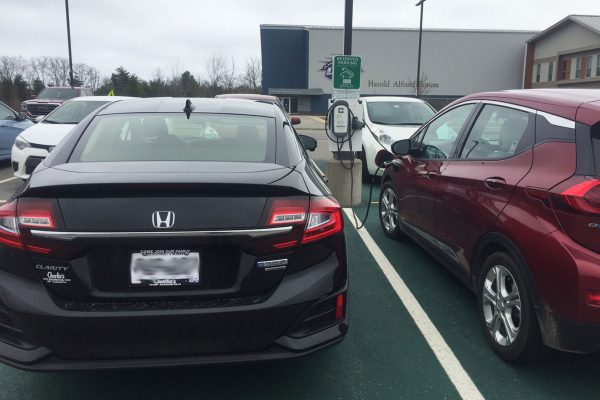In August of 2021, my husband and I decided to accept an invitation to an in-person wedding of a dear friend in southeastern Michigan, about 900 miles away from our home in Lewiston. Seeing friends and embarking on a road trip, one of our favorite ways to vacation, seemed the perfect antidote to our COVID blues. Both safety and earth friendly travel were achievable on the trip due to the vaccine requirement to attend the outdoor wedding, and the purchase of our 2018 Honda Clarity Plug-in Hybrid Touring. Few have heard of the Honda Clarity, which is the plug-in version of Honda’s mid-sized sedan, the Accord. However, we have enjoyed it immensely and have found it a flexible vehicle for multiple kinds of travel without any range anxiety. It sports the ability to travel in three different modes: electric-only, electric/gas hybrid, or HV charging mode, which re-charges the battery as you drive using gasoline.

Erin Guay and her husband (photo courtesy of Erin Guay)
We purchased the Clarity two and a half years earlier to both save money and enable a greener commute for my husband who travels 110 round trip miles to work each day. As a bonus, his employer also provides electric charging stations for staff use at no cost.
In planning our trek to the Midwest, we started to explore the ease of finding free or low-cost charging stations along our I-90 and I-80 travel route. This was a degree more challenging given that we had a limited number of travel days at our disposal and endeavored to make the 900 mile, 14-hour trip to Michigan in one day. We knew that adding hours of charge time wasn’t practical, and so our first goal was to find chargers along the route co-located with a healthy and quick meal. This leads me to my first tip: search for cooperative grocery stores along your route using apps like Plug Share. These often have free charging for their customers and also provide healthy on-the-go meals. Shout out to Honest Weight Food Co-op in Albany, New York, where we added charge to the car and bought fresh sandwiches and other goodies while we stretched our legs.
Our attempts to find other convenient charging locations along our route were thwarted by a broad renovation project, which closed more than half of the New York State Thruway service stations. Those that were open where charge was needed, only offered Level III Superchargers. Nothing is worse than the excitement of seeing an EV charging sign, only to discover the charging infrastructure leaves you out! However, there is good news. Signage indicated that charging stations would be added to all the New York Thruway rest stops in the coming year.
Upon reaching our hotel in Michigan, we benefited from a charging station reserved for hotel guests, and due to the fact we were the only plug-in travelers, we had a prime parking spot to ourselves our entire stay and were not required to move our car after charging. My second tip for plug-in travelers is to only book with those hotels offering electric charging. Not only is this a convenient re-charge option for your stay, but impresses upon the travel industry the demand for greener travel. While our electric fill-up had a charge enabled through the Charge Point app, the cost was reasonable, and charging overnight was convenient with a max cost of $3.65 for a full electrical fill-up. In my travel research I’ve found that the Hampton Inn is the major hotel chain with the biggest commitment to charging infrastructure.

Car charging station (photo courtesy of Erin Guay)
On our return trip we drove more leisurely over two days and utilized free chargers at a New York Thruway rest area and at a Massachusetts public library, where we also utilized the wi-fi. As a bonus we felt part of the greater electrical community as we received friendly waves from other electric-powered travelers.
So what was the total cost of the trip and how much did we save by traveling with a plug-in hybrid?
In total we traveled 2,300 miles, primarily in hybrid-mode, and averaged 51 miles per gallon of gasoline along with the electrical boost we procured along the way. Our total gas costs were $141 and total electrical costs were $11.26. Completing the same mileage in the comparable gas-only Honda Accord would cost $205 in gasoline. Therefore we saved $53 in total fuel costs by choosing our plug-in hybrid. While the cost savings were not enormous, consider also that plug-in hybrid vehicles require oil changes only every 6,000 or 12,000 miles so we also save on routine maintenance costs.
Our bottom line is that our plug-in hybrid serves us well as both a commuter car and a fun and comfortable car to drive across our beautiful country. We traveled with the peace of mind that we are protecting the quality of the environment and saving money. While finding electrical charging stations currently resembles a bit of a scavenger hunt, the future of electric-powered travel looks bright. The current Administration’s Infrastructure Plan includes funding for additional stations nationwide. With these infrastructure improvements, next on our wish list is to replace our SUV with an electric version, and continue to encourage our kids to invent the first solar and electrically powered RV with a 1,000-mile range. Bring on the open road!
—guest post by Erin Guay










Leave a Reply